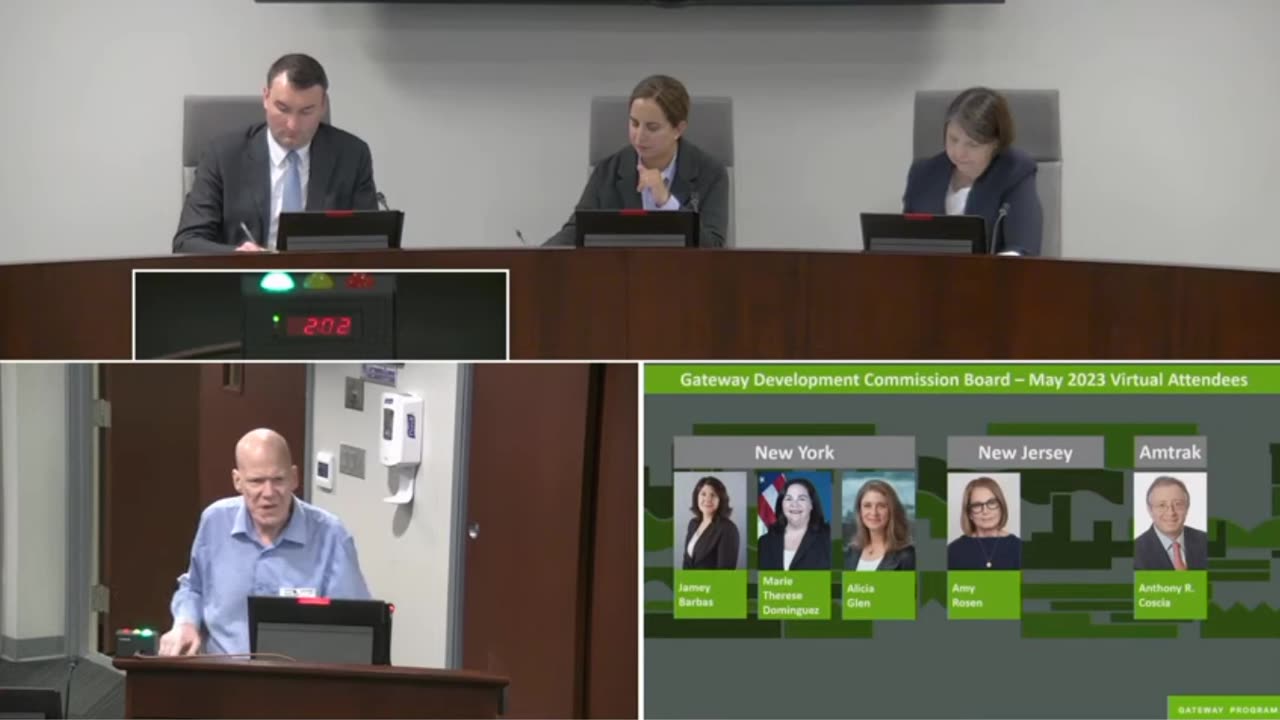Premium Only Content

"Tunnel must be Demolished" - Gateway Tunnel Commission, 5/2/23 (see the description for details))
I MUST RECANT! The old description of the ground stabilization project was so precise and carefully presented that I never stopped to think they might revise it. Apparently this new version - with a 550-foot-long cofferdam and hardening of the river bottom that extends into the navigation channel - includes a revised alignment of the as yet only partially built "box" in Manhattan: to make the west end higher, thus reducing the former three-or-so-percent grade to 2.1%. (It appears this will involves introducing a reverse curve in the vertical alignment of "the box".) The tunnel will now enter the river bottom at one side and run along a uniform 'inclined plane' to the other. It is a novel solution - and I would say ill-advised - to build a rail tunnel through a tidal estuary so close to the bottom of a big navigable channel. And the general standard for low cover in NORMAL conditions is one tunnel breadth, not one half, as the new documentation asserts.The ruling grade in the old tunnel is something like 1.97% - and it runs considerably deeper under the river bottom than the new one.
I still say the old tunnel needs to be demo'd and rebuilt, because the south tube flexes quite a bit on the Jersey side where locomotives pass from bedrock into the wet, silty river bottom at 60 mph - every three minutes for the past 114 years. By far the most severe leaking and water damage in all the six underwater Penn Station tunnels occurs at this location. To some degree it's probably due to the old method of construction, with a continuous row of cast iron "key segments" running the length of the bored section at the top, which are stiffer than the normal segments comprising the remainder each ring. Most of the severe leaking occurs on either side of these stiffer key segments. (my theory, I have no bona fides)
The whole tunnel moves up and down with the tide measured in inches, but that's normal. Damage to reinforced concrete left unattended still twelve years after the fact cannot be repaired, and the deterioration "progresses exponentially" - to quote an oft' repeated-by-engineers description of the process. (like the Surfside condominium tower) The one English bidder with an astronomical price did not contemplate anything like replacing the 40 special 1-inch-thick lengthwise re-bars (which were sort of an afterthought) spliced together at intervals and running the length of the bored segment, i.e. 1.25mi. - times two. Without, the old re-bars will just start to rust again, and any new concrete will pop right off in a matter of a few years, leaving the re-bars exposed to continue rusting. Nor did they contemplate taking the concrete lining down to bare metal (necessary for visual inspection, making repairs, plugging leaks, and arresting the rust) which would probably be dangerous, and require working under pressure - THUS COSTING MORE THAN IT WOULD TO DEMOLISH AND REBUILD THE TUNNEL.
The bored segments (two) are each about 1.25 miles long. The still-longer underground approaches - mined through bedrock at cost of life and limb - are already in place. See: Hudson Tunnel Project vs. the Correct Alternative, at https://www.rail-nyc-access.com - for more on the exponentially complicating factors involved in getting this project wrong - results of which will be permanent.
-
 4:27:46
4:27:46
Nerdrotic
16 hours ago $58.86 earnedDaredevil Born Again REVIEW, Harry Potter Show DOA, DC HACKED! | Friday Night Tights 344 Paul Chato
175K51 -
 1:15:15
1:15:15
Glenn Greenwald
13 hours agoWeek in Review: Lee Fang and Leighton Woodhouse on Ukraine War and NYT Piece Revealing Tensions within Trump Admin; PLUS: Lee Fang Takes Audience Questions on DOGE and Big Tech | SYSTEM UPDATE #420
110K54 -
 1:03:30
1:03:30
Sarah Westall
16 hours agoMassive Government Overhaul: FBI, CIA, IRS and more to be Gutted w/ Sam Anthony
110K32 -
 1:07:40
1:07:40
IsaacButterfield
16 hours ago $5.61 earnedAustralia Under Attack | Trump's State of the Union | All LGBTQ Cast (W Guest Frenchy)
60.9K15 -
 1:23:37
1:23:37
Edge of Wonder
15 hours agoIs Your Car Collecting Your Biodata? Whistleblower Exposes Dark Agenda
55.3K13 -
 2:08:50
2:08:50
Quite Frankly
18 hours ago"A Rat at HHS, Gene Hackman, Musical Extras" ft. J Gulinello 3/7/25
55K15 -
 55:49
55:49
LFA TV
1 day agoGermany Started Two World Wars and Now Wants Nuclear Weapons | TRUMPET DAILY 3.7.25 7PM
46.3K48 -
 1:34:38
1:34:38
2 MIKES LIVE
14 hours ago2 MIKES LIVE #189 Open Mike Friday (Sort Of)
33.4K -
 1:48:14
1:48:14
Right Side Broadcasting Network
22 hours agoLIVE REPLAY: President Trump Delivers Remarks at The White House Digital Assets Summit - 3/7/25
155K43 -
 2:07:17
2:07:17
The Quartering
20 hours agoTrump Goes Ballistic On Russia & Ukraine Gets Results, Democrat Cringe, FBI Arrests Military Men
150K84